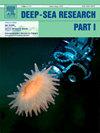Megafauna of the RMS Titanic shipwreck and a nearby seamount ridge in the deep sea of the western North Atlantic
IF 2.1
3区 地球科学
Q2 OCEANOGRAPHY
Deep-Sea Research Part I-Oceanographic Research Papers
Pub Date : 2025-06-15
DOI:10.1016/j.dsr.2025.104544
引用次数: 0
Abstract
The biology of shipwrecks and hard substrata in the deep sea remains poorly explored. These complex habitats alter biodiversity on the deep seafloor and facilitate connecting populations over large distances. We analysed biological and environmental data collected at the RMS Titanic wreck site (3800 m) and a seamount ridge (2900 m) during the 2022 Titanic Expedition (15 June–25 July). The ridge is part of Seamount U, approximately 40 km southeast of the Titanic, and was explored for the first time on July 23, 2022. We analysed megafaunal occurrence across 920 images of the wreck site and 169 images of the ridge site, from digital video. The most common megafauna overall were Ophiuroidea, Munidopsis sp., Cushion-Encrusting Porifera, Geodia spp., and cold-water corals including Keratoisididae and Pennatuloidea. We describe the patterns in community composition across five benthic habitats, likely controlled by substrate type, local hydrodynamics, and food availability. The ridge yielded a higher number of observed megafauna and higher Shannon diversity (n = 73; H = 2.89) than the wreck (n = 21; H = 1.39). The communities associated with the ridge showed high dissimilarity to those at the wreck. We also explored the temporal variability of biofouling organisms on the Titanic using video from 1986 to 2022. We observed a net increase in Chrysogorgia sp. and Lepidisis sp. coral colonies over time with estimated average linear growth rates of up to 10 mm/yr and linear rusticle extensions of up to 14 mm/yr, raising questions about the wreck's ecological succession as it deteriorates.
泰坦尼克号沉船上的巨型动物和北大西洋西部深海附近的海底山脊
沉船和深海中坚硬基质的生物学研究仍然很少。这些复杂的栖息地改变了深海海底的生物多样性,并促进了远距离种群之间的联系。我们分析了2022年泰坦尼克号探险(6月15日至7月25日)期间在泰坦尼克号沉船遗址(3800米)和海山脊(2900米)收集的生物和环境数据。该山脊是U号海山的一部分,位于泰坦尼克号东南约40公里处,于2022年7月23日首次被探索。我们分析了920张沉船现场的图像和169张山脊现场的图像,这些图像来自数字视频。总体而言,最常见的巨型动物是蛇科、Munidopsis、垫壳Porifera、Geodia和冷水珊瑚,包括Keratoisididae和Pennatuloidea。我们描述了五种底栖生物栖息地的群落组成模式,可能受基质类型、当地流体动力学和食物供应的控制。脊区有较多的巨型动物和较多的Shannon多样性(n = 73;H = 2.89)大于沉船(n = 21;h = 1.39)。与山脊相关的群落与沉船处的群落表现出高度的差异。我们还利用1986年至2022年的视频,探索了泰坦尼克号上生物污染生物的时间变化。随着时间的推移,我们观察到Chrysogorgia sp.和Lepidisis sp.珊瑚群落的净增长,估计平均线性增长率高达10毫米/年,线性锈迹延伸高达14毫米/年,这引发了对沉船生态演替的质疑。
本文章由计算机程序翻译,如有差异,请以英文原文为准。
求助全文
约1分钟内获得全文
求助全文
来源期刊
CiteScore
4.60
自引率
4.20%
发文量
144
审稿时长
18.3 weeks
期刊介绍:
Deep-Sea Research Part I: Oceanographic Research Papers is devoted to the publication of the results of original scientific research, including theoretical work of evident oceanographic applicability; and the solution of instrumental or methodological problems with evidence of successful use. The journal is distinguished by its interdisciplinary nature and its breadth, covering the geological, physical, chemical and biological aspects of the ocean and its boundaries with the sea floor and the atmosphere. In addition to regular "Research Papers" and "Instruments and Methods" papers, briefer communications may be published as "Notes". Supplemental matter, such as extensive data tables or graphs and multimedia content, may be published as electronic appendices.

 求助内容:
求助内容: 应助结果提醒方式:
应助结果提醒方式:


